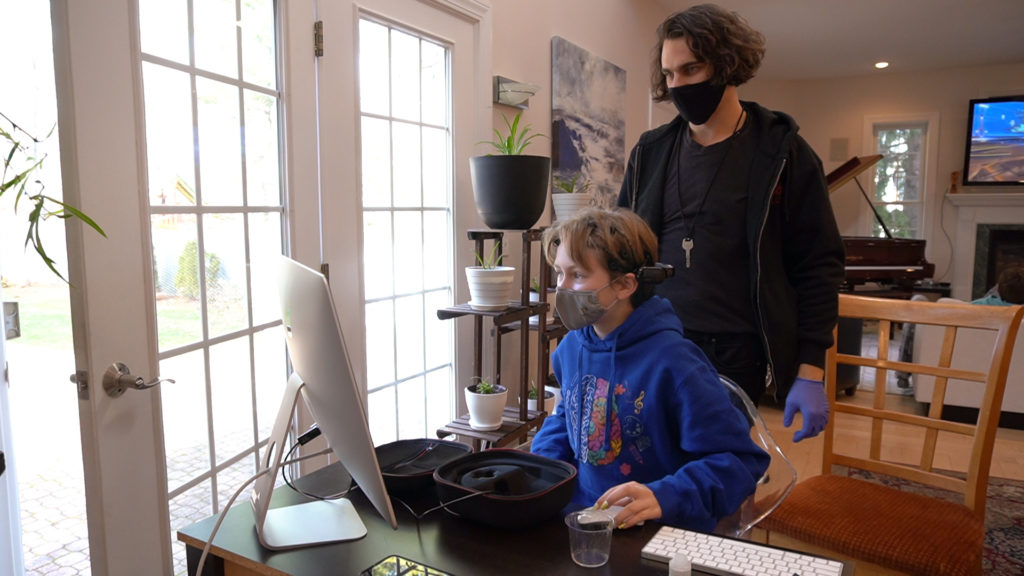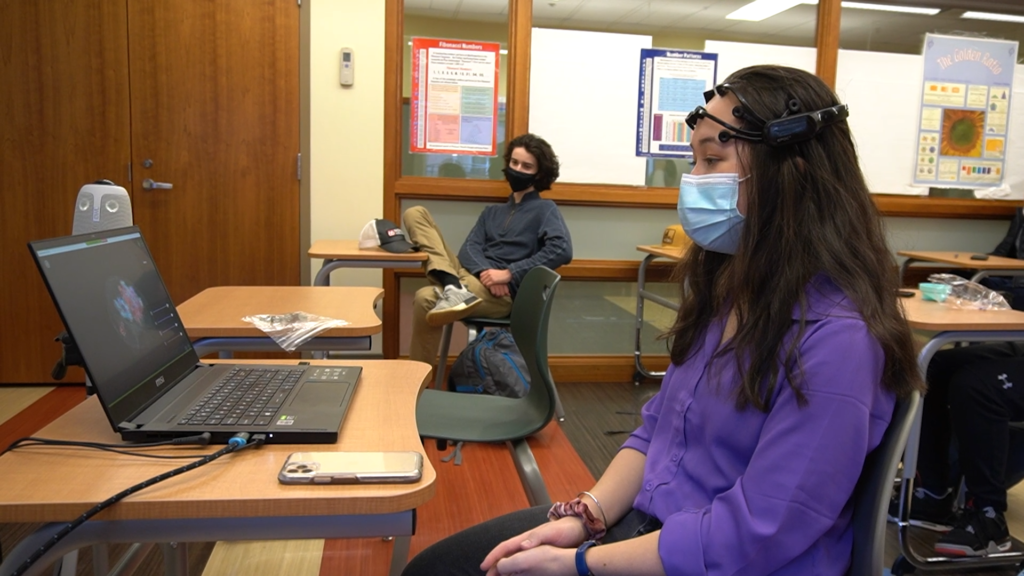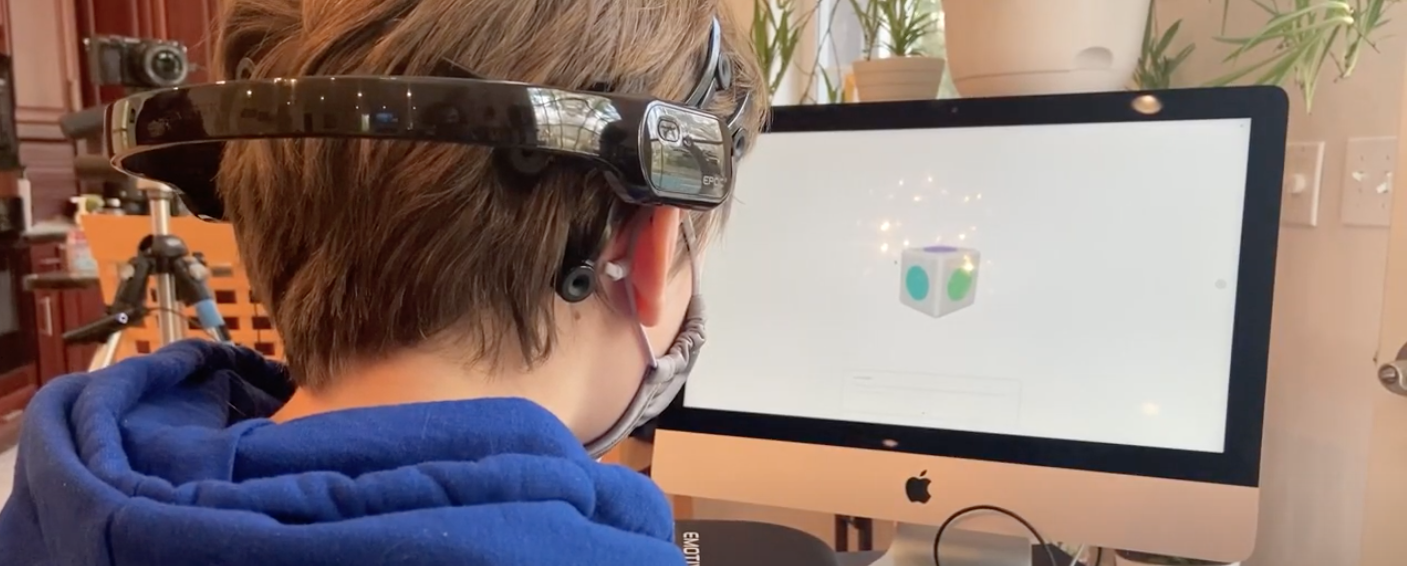Neuroscience enrichment courses offer EEG devices for student use
The Aerie Enrichment Program and Wheeler Science Department acquire three headsets to launch neuroscience programs for Lower, Middle, and Upper School students.
Did you know that between your two ears sits the most complicated object known to exist in the entire universe?
It allows you to dance at parties, cry at funerals, play video games at 4 in the morning, and eat burritos while having conversations with good friends. That thing is your brain, a squishy series of electrical impulses and molecules that communicate at speeds faster than a bullet train!
Thanks to the generosity of a Wheeler family and sparked by the visit of an Aerie enrichment teacher to a 4th-grade science class last spring, the School has acquired three Brain Machine Interface (BMI) headsets — the Muse, the NextMind, and the Emotiv Epic X — opening up neuroscience studies for students of all ages at Wheeler.
The Wheeler Neuroscience program aims to educate K-12 students on the structure and function of the brain as well as the scientific process by which information about the brain is acquired. Particular focus is directed to Brain Machine Interfaces (BMI), devices that convert the electrical pulses of the brain into signals that can be used to control computers and machines. Community building and engagement are essential components of the program which has been created through the Wheeler Aerie Approach — an enrichment and R&D component of the school’s curriculum in place for more than four decades.
While Wheeler is not the first school in the country to use techniques from neuroscience in its classrooms, it is among the few in the nation to make brain devices an available part of its enrichment and science curriculum by acquiring the equipment and developing coursework for using them.
Currently, Aerie teacher Travis Dumais uses the devices with Lower School student Ella Nickerson in an independent neuroscience study and also with Upper School students in a special Aerie neuroscience elective. Last spring, Nickerson was inspired by a presentation in her 4th grade Wheeler science class with teacher Julie Abodeely to raise funds (selling “Baklava for Science”) to donate the first of the devices to the school and also support the Aerie Approach for more students at Wheeler.

Above: 5th grader Ella explains EEGs
How the devices work with the brain
Aerie teacher Travis Dumais manages the new program. “I spent the past nine years researching neuroscience, moral decision making, religious belief, and mindfulness meditation.” Dumais received his Masters in Psychology from Rhode Island College in collaboration with a neuroscience research lab at Brown University. While working with Dr. Willoughby Britton, a leading expert in the science of mindfulness meditation and Assistant Professor of Psychiatry and Human Behavior, Assistant Professor of Behavioral and Social Sciences at Brown, Dumais studied the effects of mindfulness on sleep and co-authored papers on the health impacts of meditation (2020). As an undergrad, he studied the relationship between religious belief and moral decision-making (2013).
He describes in non-scientific terms the basics of the brain and how the new devices work.“The brain is made up of a bunch of tiny units of life called cells. Some of these cells are called neurons,” he said. “There are about 100 billion neurons that make up your brain and spinal cord and their primary function are to send signals to each other. And these signals code information. For instance, neurons in the back of your brain code visual information. If you were injured in the back of the head by a blow with a hammer, for instance, you could go blind.
Below: A visual output of brain activity recorded while a student uses one of the new devices at Wheeler.
“Neurons use both electricity and chemicals to talk to each other. Each time a neuron sends a signal, there is a small electrical pulse that is given off. Just a single neuron does not give off a lot of electricity, but thousands of neurons sending signals at the same time give off enough electricity to be detected on the surface of your skull” explains Dumais. “So, scientists put sensors on the surface of people’s skulls to pick up on those electrical pulses and use those pulses to get an idea of what your brain is doing. You can even use these pulses to control a computer or machine.”

Below: 11th grader Mia Shih explains what it’s like to see your brain at work for the first time.
Students have access to three devices
Currently, The Wheeler School owns three brain headset devices. These devices are called Electroencephalograms or EEG for short.
The Muse
The first device, The Muse, was designed to provide biofeedback for meditation practice. Students have extracted the raw EEG signals from this device to conduct experimental demonstrations on a range of topics including the effects of music on the brain.
The Emotiv Epoc X
The Emotiv Epoc X is one of the most powerful consumer-grade EEG headsets on the market. Not only does it allow a real-time readout of brain activity but it also has the capacity to function as a Brain Machine Interface (BMI). Students who use the headset will be some of the first people in the world to control objects on a screen just by thinking. The software allows for the control of other devices, such as turning lights on and off, playing electronic pianos, and even moving a drone using mental commands. This device can also detect facial expressions from brain activity.
The NextMind
The NextMind uses electrical pulses from the visual cortex in the back of your brain to move and select objects on screen Watch below as Lower School third-grader Carston Levey Friedman uses the device to make music and play a game.
Can’t see this video because you did not accept cookies? Try here.
Weaving Curriculum With Diversity, Empathy, Science
In collaboration with Lower School Science faculty member Julie Abodeely, an age-appropriate Neuroscience Unit was piloted last year (2019-2020). The goal is to teach the basics of neuroscience and inspire young students to think about how the brain functions in everyday life. In addition, students in grades 4-12 at Wheeler have access to enrichment courses in neuroscience using the devices.
The elementary-age program hopes to promote Wheeler’s additional aim of diversity, equity, and inclusion by discussing various elements of neurodiversity, bias, and empathy in order to provide intellectual tools that will help the youth grapple with the social challenges of our times. In the video below, students with learning differences at Wheeler’s Hamilton School division watch a classmate’s brainwaves while meditating.
A number of offerings for high school students have begun as students learn to use the devices, including independent studies, and enrichment courses at both introductory and advanced levels.
Can’t see this video because you did not accept cookies? Try here.
Community Outreach: Podcasts, Videos, Events
Collaborations with the Wheeler School Broadcasting department, Brain Station, and Wheeler’s Science Department are currently in development to promote neuroscience awareness and research throughout the wider Wheeler, Rhode Island, and global communities.
- Podcast (Wheeler School Broadcasting and Brain Station)
Promoting neuroscience education within the community is a key goal of the Wheeler Aerie Neuroscience Program. In collaboration with the founder of Brain Station (more below) as well as the Wheeler Broadcasting Studio (David Schiano and Jesse Yip), a podcast will be created whereby students of any age will be given the opportunity to engage with experts in the field for a live, recorded discussion that will be broadcast to the community at large. - YouTube
Students enrolled in the Aerie Neuroscience elective program at Wheeler will have the opportunity to publish their work from class in a public forum via YouTube. With guidance from the Wheeler Broadcasting Studio (David Schiano, Jesse Yip, and Travis Dumais), students will gain expertise in how to present information in a fun, modern, and informative way to the community. - BrainStation
BrainStation is a nonprofit organization founded by Ian More, a Ph.D. student at Brown University studying gamma wave EEG activity and attention. In collaboration with BrainStation, Wheeler’s Aerie enrichment Neuroscience Program intends to reach out to underserved communities to teach about the brain and host demonstrations using The Muse and Epoc X technology. Students from Wheeler will provide assistance and gain community engagement and teaching experience through this program as well as build relationships with the youth throughout the state.
Want to know more?
While Wheeler is not the first school to use techniques from neuroscience in its classrooms, it is among the few in the nation to make the brain devices an available part of enrichment and science curriculum by acquiring the equipment and developing coursework and community outreach for greater understanding of this incredible topic. For information, contact Travis Dumais, Wheeler Aerie enrichment teacher.
